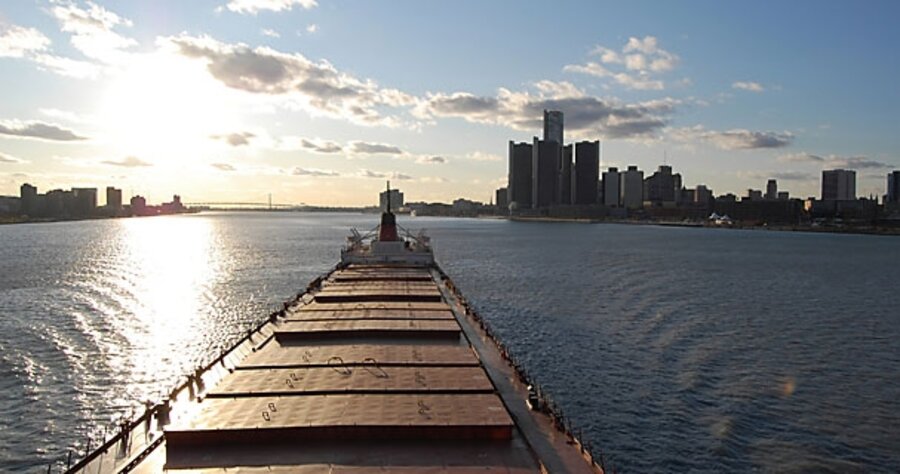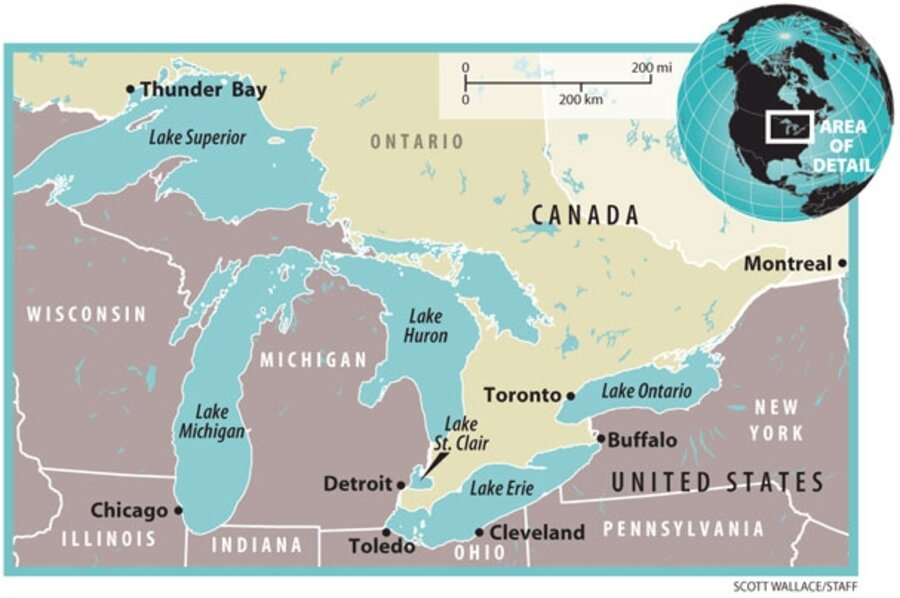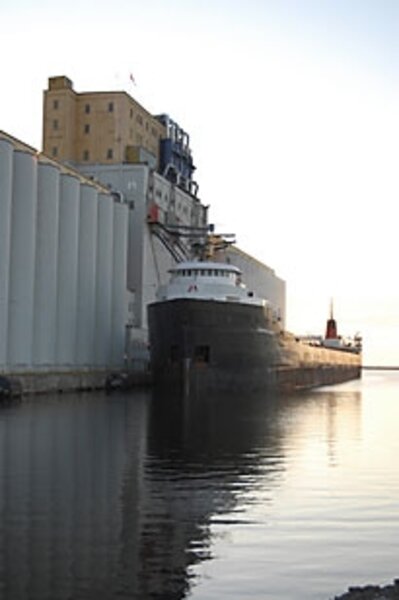Great perils of the Great Lakes
| Aboard the bulk steamer Canadian Leader
On a starry night, the 730-foot Canadian Leader, the last bulk-carrying steamship built on the Great Lakes, slips silently past illuminated buoys near Montreal on a five-day voyage up to Thunder Bay, Ontario, on Lake Superior.
After unloading titanium ore at the St. Lawrence River port of Sorel, the ship is proceeding empty toward the upper lakes. With the recent economic downturn, there is less demand for her typical upbound cargo of iron ore pellets. Capt. George Wheeler, a 40-year veteran of the sea originally from Northern Ireland, has taken on freshwater ballast from the river, to maintain the ship’s stability and maneuverability.
Taken together, the Great Lakes are a vast inland sea representing over one-fifth of all surface fresh water on the planet. More than 40 million Canadians and Americans draw their drinking water from the lakes, which play a vital role in public health, the environment, industry, commerce, and leisure.
But there are causes for concern: invasive species, declining water levels, uncertain quality of drinking water, and pressures to divert water from and into the Great Lakes-St. Lawrence basin. Signed into law by President George W. Bush Oct. 3, the Great Lakes Compact takes effect Dec. 8. The binational agreement, the fruit of regional initiatives, obliges eight American states and two Canadian provinces to work together to protect the lakes system.
“The Great Lakes Compact is an awesome victory,” says Jeff Skelding, national campaign director for Healing Our Waters – Great Lakes Coalition. “No one predicted it could have happened so quickly. We can’t protect the Great Lakes if there’s no water in them…. The cocktail of assaults may be pushing the Great Lakes toward a tipping point, an irreversible change in the food web.”
Part of this assault is the introduction of 182 invasive species such as the zebra mussel, which began disrupting the food web on Lake St. Clair in 1988 and has clogged many water intake pipes since, at an annual cost running in the billions of dollars.
Typically, “salties” (oceangoing ships) reaching the Great Lakes from overseas via the St. Lawrence River have discharged invasive species along with their saltwater ballast once they reached lake ports. Lakers have unwittingly transported these invasive species in their freshwater ballast, from one point on the lakes to the next.
Zebra mussels have made lake water look cleaner than before. But for Mr. Skelding, the clarity of water is a problem. “Sure, zebra mussels filter water,” he says, “but when the water is clearer, sunlight penetrates deeper, and organic material proliferates and absorbs much-needed oxygen in the water that is needed by fish and microorganisms.” The result: “Dead zones.”
Now a new pest is closing in on the lakes: Asian carp from the Mississippi and Illinois Rivers have nearly found their way through the Chicago River to Lake Michigan.
“What gets into the Great Lakes can work through the country like a computer virus and dismantle the biology of systems,” says Cameron Davis, president of the Chicago-based Alliance for the Great Lakes (AGL), a citizens’ group of 6,000 professionals and volunteers working for clean water in the Great Lakes. The choke point is a 10-mile stretch of the Chicago River, the Chicago Sanitary Ship Canal. “The bad news is,” Mr. Davis continues, “even if we know where the choke point is, we are having a hard time taking action.”
The Great Lakes Compact is expected to give federal, state, and provincial governments more muscle to take preventative action against invasive species.
Storms and surges a danger
Venturing “light ship” (without cargo) across the stormy lakes of autumn can be unsettling. When 50-knot northerly winds lash the surface of Lake Erie, sending some lakers into sheltered anchorages, Captain Wheeler decides to maintain course. Lake Erie is shallower than the other great lakes and more likely to be whipped up by storms. Ships at anchor off Toledo, Ohio, may suddenly find themselves aground when a short-term natural effect called “seiching” (pronounced “SAY-shing”) drives surface water towards Buffalo, N.Y., at the eastern end of Lake Erie.
Despite a few seasonal blips, a 30-year trend shows that water levels are declining. This is one of the main reasons the Great Lakes Compact was rushed into law. Canadian and American entrepreneurs alike had been seeking ways to commercialize the freshwater resources of the Great Lakes, hoping to send it by pipe or ship to thirsty markets in the US Southwest and overseas.
Still, the Healing Our Waters – Great Lakes Coalition predicts that lake levels could drop this century by one foot on Lake Superior, three feet on Lakes Michigan and Huron, 2.7 feet on Lake Erie, and 1.7 feet on Lake Ontario.
Water levels are also a challenge for American ship operators, the largest of whose vessels are “1,000 footers” designed to carry 70,000 tons. The largest Canadian bulk carriers, like the Canadian Leader of the Upper Lakes Group, carry only half that much.
“Water levels are very important to us,” says Glen Neksavil, vice president of the Lake Carriers Association, a trade association based in Rocky River, Ohio, which represents 16 American companies operating 63 vessels exclusively on the lakes. “When water levels were high back in 1997, some of our ships were carrying 70,000 tons of cargo per trip. This year, they are carrying 66,500 tons.... Our largest ships lose 270 tons of cargo for each inch in draft caused by lower water,” he says.
“The US Army Corps of Engineers estimate they have a backlog of 17 million cubic yards of sediment in virtually every US port on the Great Lakes,” says Mr. Neksavil. “That would cost $230 million to dredge. The Harbor Maintenance Trust Fund is funded by a tax on cargoes, and currently has a surplus of $4.8 billion, which I think the government is using to balance its books.”
Drinking-water safety an issue
The Canadian Leader slows at Ambassador Bridge, on the Detroit River between Lake Erie and Lake St. Clair, long enough to pick up mail for the crew. Tundra swans and snow geese laze on the sparkling water.
Detroit draws its drinking water from the river, and the concentration of ships, steel mills, and car plants here reminds one how dependent Great Lakes communities are on freshwater resources.
“Drinking water from the Great Lakes is the envy of the world,” Davis says.
But a series of scientific reports has raised concerns about drinking water in Detroit and other communities. Trace amounts of pharmaceuticals flushed down toilets have found their way into river water. Byproducts of chlorine treatment and disinfection, coliform bacteria, and lead also pose health risks. Canadian petrochemical plants at Sarnia on the St. Clair River are also a concern.
Sewage overflows are a major problem. “During heavy rainstorms,” Davis says, “it’s easy for treatment plants to risk being overwhelmed. There are two things we can do to help: conserve water, so that we’re not using as much, and use ‘green infrastructure,’ like rooftop gardens, to cut the amount of stormwater that needs to be treated.”
On to Thunder Bay, Ontario
Under cover of night, the Canadian Leader transits the Soo lock on the St. Mary’s River between Michigan and Ontario, passing a huge windfarm on the Canadian side. Then it’s 18 hours of steaming out of sight of land, across glittering Lake Superior, before docking at a grain elevator in Thunder Bay to pick up a 28,000-ton load of durum wheat.
Lake Superior’s temperature is rising, says Jay Austin, an oceanographer at the Large Lakes Observatory of the University of Minnesota at Duluth. “Temperature is the most important environmental variable” in a lake, he says. It determines “the chemical reaction rates, the metabolism rates of fish, phytoplankton, and zooplankton, and the spawning rates of fish.”
Mr. Austin and his colleague Steve Colman are deploying an array of moorings at different depths in Lake Superior, from just below the surface to some 1,300 feet down, just above the lake bottom. “Surface water in Lake Superior is warming faster than the air temperature,” he says. “Lakes Michigan and Huron also seem to be experiencing the accelerated warming phenomenon, although not Lake Erie.”
Less ice cover in winter means more evaporation, which in turn lowers water levels, stressing ecosystems. Austin says change on this scale is hard to imagine, much less control. The warming of the Great Lakes is its latest challenge, he says – perhaps its most serious one.







